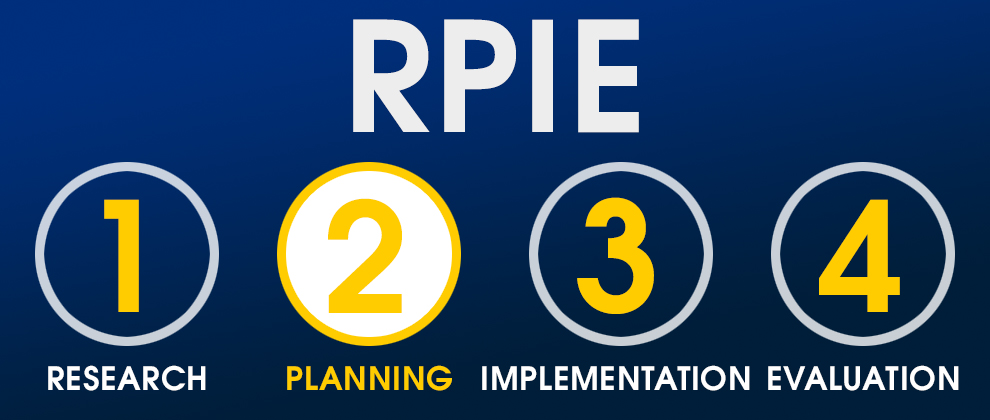RPIE Part 2 – It’s as Delicious as it Sounds (Planning)
by Nicholas Chopp
Planning – What’s Your Intent?
Think about the last time you posted on Facebook, Instagram, or Twitter for your business. What did you post, and more importantly, WHY did you post it? Who were you trying to reach, and what were you trying to communicate?
Just like paint correction, ceramic coating, or vacuuming an interior, communicating effectively isn’t an accident. Think about your process for paint correction – do you just grab a random buffer, pad, and compound and get to work?
If you’re reading this blog, I think we can safely assume you have a process. You’ve already washed and decontaminated the vehicle, so now you’re ready for polishing. If it’s a single-stage polish on a dark vehicle, you’re grabbing a polishing pad and a mild compound for your first test spot. Or maybe your experience has shown you that Infiniti’s jet black paint is typically very soft, so you’re going for a polishing pad and a fine polish. You’ve developed a plan in your head of how you’re going to tackle the job – you’re not just winging it.
To communicate effectively, we have to approach it the same way – starting with your intent.
Planning – Developing Intent
This part is relatively easy – what is the effect you’re trying to achieve? Are you trying to drive repeat business? Are you looking to develop new customers? Are you advertising a sale? Or are you just posting because you haven’t done anything on your social media page for a while, and feel like you should? I challenge you to have a clear intent with every communication effort you have. This should tie back to your core competency. Stick to what you’re good at!
KAB
KAB stands for Knowledge, Attitude, and Behavior. All of our communication efforts need to be focused on influencing at least one of those factors in our target audience. For example, a blog post focused on how to what to expect at the vehicle processing center (VPC) to ship their vehicleis going to attempt to affect all three:
- Increase their knowledge on how particular the VPC can be about cleanliness (knowledge)
- Influence their desire to avoid adding even more stress to the moving process (attitude)
- Increase the likelihood of them choosing us to help them reduce that stress (behavior)
On the other hand, a Facebook post advertising a paint correction special may only be trying to affect behavior (their willingness to purchase the package). But if you tie in a quick explanation on what paint correction is for, you’re now also trying to increase their knowledge – which will likely affect their likelihood to make that behavior choice you’re looking for.
Communication Goals
Ok, so we’ve established what KAB we’re looking to alter – now we can develop a communication goal. Goals need to be SMART:
- Specific: Well defined, clear, and unambiguous
- Measurable: With specific criteria that measure your progress toward the accomplishment of the goal
- Achievable: Attainable and not impossible to achieve
- Realistic: Within reach, realistic, and relevant to your business goals
- Timely: With a clearly defined timeline, including a starting date and a target date. The purpose is to create urgency.
- Cited from CorporateFinanceInsitute, for more on goal setting read their article here.
Example: To increase sales of my VPC prep package for the 4th quarter of 2021 (compared to the previous quarter) by increasing their knowledge on VPC cleanliness requirements, influence their desire to reduce the stress of moving, and increase their likelihood of selecting our service to help them reduce that stress.
This goal meets all of the SMART requirements. It’s clear, I can easily measure it through my Square invoicing, it’s absolutely achievable, it’s realistic, and I’ve defined my target date.
Conclusion
There are often no “right or wrong” answers in communication – it’s frequently shades of grey, or levels of effectiveness. What’s important is being DELIBERATE in your process of communication. Next up will be Implementation – where the rubber meets the road.
Related Posts
- RPIE Part 5 – It’s as Delicious as it Sounds (Evaluation)
- RPIE Part 4 – It’s as Delicious as it Sounds (Implementation Part 2)
- RPIE Part 3 – It’s as Delicious as it Sounds (Implementation)
- RPIE Part 1 – It’s as Delicious as it Sounds (Research)
- 3 Easy Rules for Short Form Content on Tiktok, IG and FB Reels








No comments yet. Be the first!